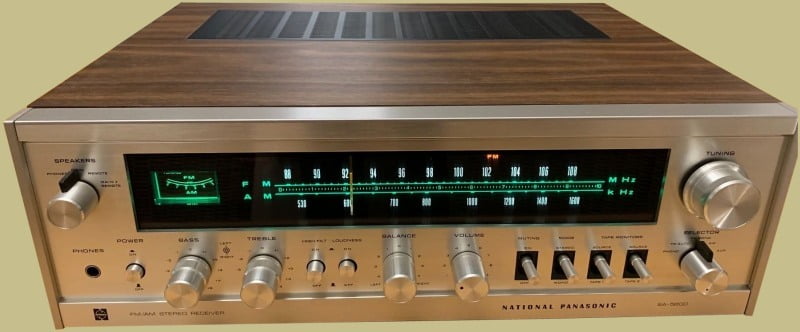
The Panasonic SA-5800 receiver hit the market in 1972 and retailed for $259.95. It was engineered by Matsushita Electric Industrial Co. of Japan. Matsushita’s engineers were able to achieve an appealing mix of features and performance capabilities in a relatively inexpensive receiver. And, they included them in a very nicely designed package. The only qualms I have with the design are the somewhat strange looking selector switch knobs. It produced 23 watts per channel into 8 ohms when powering both channels (27 watts per channel when powering each channel separately).

The face plate is made of heavy, extruded, light-gold anodized aluminum. The SA-5800 was part of Panasonic’s receiver lineup in the early 1970’s that included the top-of-the-line SA-6500, the SA-6200, the SA-5800, the SA-5500, and the SA-5200.

Panasonic marketed the SA-5800 with the tagline: “Get an Earful of Pure Sound!” Their brochure stated that the SA-5800 was, “The well-bred child of a close knit family of electronics wizards.”
In fact, Panasonic had a number of humorous marketing phrases such as:
“…More than sufficient to engulf your whole house in a sea of crystal pure sound.”
“Whether you want to lose yourself in the driving rhythms of Jazz or the New Rock, or slide into that warm, classical world, let the SA-5800 be your magic carpet.”
“Its vibrant power will set a crowd swinging to the throbbing beat, or gently soothe the meditative individual.”
Hard to pass up a receiver that can do all that!
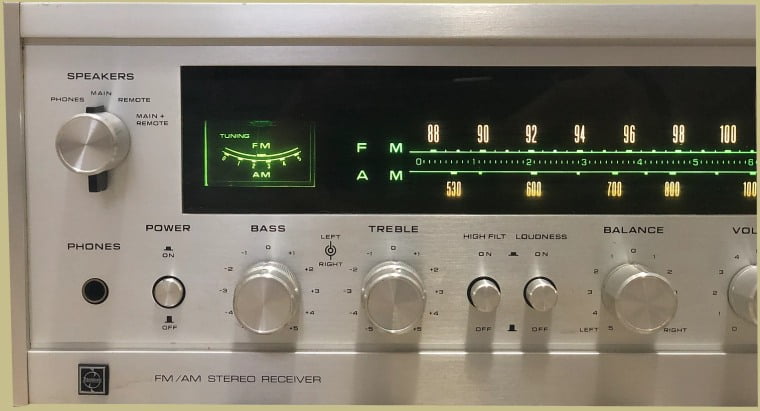
The Panasonic SA-5800 has the usual features for a moderately priced stereo of the time. Bass and treble controls, high filter, loudness control, a small tuning strength meter, and of course, balance and muting controls. The tone controls are concentric knobs, permitting individual channel adjustment of both bass and treble.
The tuning meter is dual function. When tuning AM, the meter will swing further to the right the stronger the signal. When tuning FM, it becomes a center tuning meter and the closer the meter to center the stronger the FM signal.
The dial face includes an appealing green, linear, slide rule tuning dial along with amber frequency numbers contrasting against a black backdrop. The program and stereo indicators are all red. One cool feature of the SA-5800 is that the dial pointer will glow a marigold color when it is perfectly centered on a signal. Otherwise it will remain unlit.
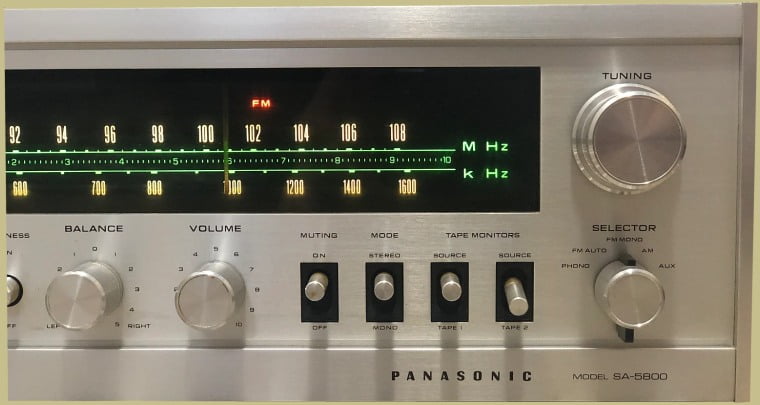
The FM section of the SA-5800 is very good. It uses a MOS-FET design with a 4-gang tuning capacitor. The whole circuit is on a sub-chassis that is completely shielded to reduce interference and distortion from power hum. In fact, the SA-5800 has very good IHF sensitivity across the dial. Most manufacturers at the time optimized their tuner sensitivity to the 98 MHz range which was the “official” frequency to test for sensitivity. Sensitivity would then fall off to lower performing levels at either end of the frequency range. Matsushita didn’t do this which is why their FM tuner is so good. The signal to noise ratio was published as 60dB but was measured by two different testers at the time and measured 64dB and 72dB which is very good.
The phono section isn’t bad either. A leading audio magazine of the time said:
“…in playing records…we were aware of a certain sweetness and liveliness of detail both in big orchestral passages and in the reproduction of solo instruments“.
Specifications:
- Tuning range: FM, MW
- Power output: 23 watts per channel into 8Ω (stereo)
- Frequency response: 15Hz to 65kHz
- Total harmonic distortion: 0.5%
- Damping factor: 70
- Input sensitivity: 2mV (MM), 180mV (line)
- Signal to noise ratio: 62dB (MM), 77dB (line)
- Output: 180mV (line), 60mV (DIN)
- Speaker load impedance: 4Ω to 16Ω
- Dimensions: 16″ W x 5 1/2″ H x 14″ D (406 x 140 x 356mm)
- Weight: 24 lbs (10.9kg)
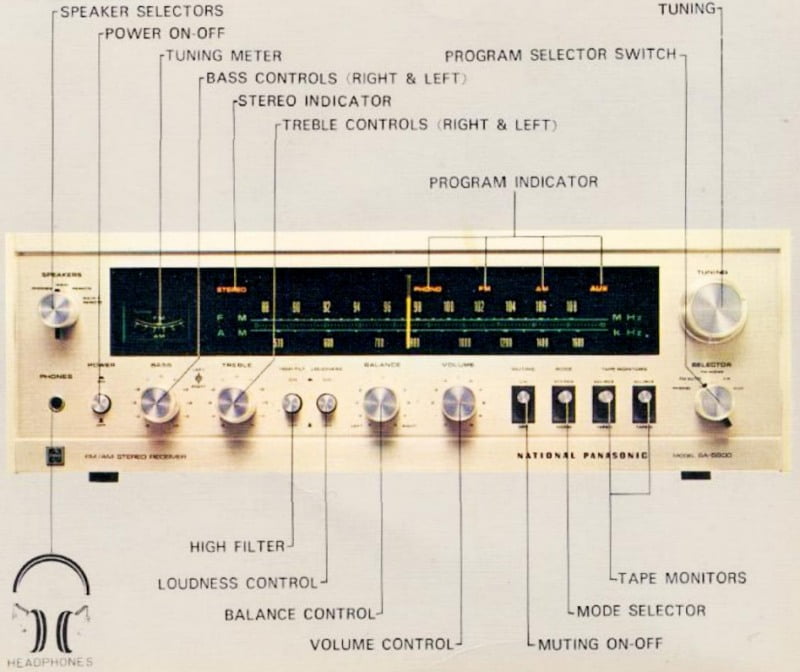
The SA-5800 had somewhat unique circuitry for its time – especially for its price range. They utilized a direct-coupled output circuit design which eliminated the need for both the input and output transformers as well as the output capacitor. This design reduced the level of noise and distortion emanating from the amplifier section significantly. It also widened the frequency response while at the same time boosting the damping factor. The pre-amp is well designed also. It uses low noise transistors and a 2-stage PNP-NPN directly coupled equalizer.
It looks like the SA-5800 has plenty of heat sinks around the power output transistors as well. You can see the shielded tuning circuit at the top right.
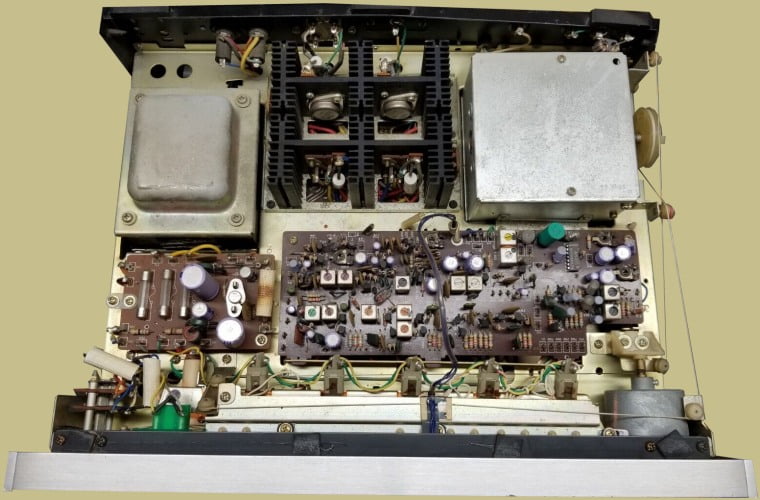
The back panel of the SA-5800 has connections for Phono (magnetic cartridge), aux, tape 1, and tape 2, and two tape recording outputs. Input and output for tape 1 also can be connected through a DIN socket. In addition there are preamp-out and main-in pairs that are connected by jumpers. With the jumpers re-moved these jacks can be used to insert a quadraphonic decoder, speaker equalizer, or similar unit into the circuit just ahead of the power amplifier. There are two AC outlets, one of which is controlled by the receiver’s on/off switch.
There are a pair of speaker protection fuses, a center -channel output jack (requiring a power amplifier if it is to be used for a center -fill speaker system), and a ferrite bar antenna as well. As you can see the SA-5800 has nice, slightly oversized speaker binding posts for two sets of speakers.

Overall the Panasonic SA-5800 is a great performing mid-range receiver. It has most of the features you’ll ever need and looks great too. It may be a little under powered for some but, if you don’t need a lot of power, its excellent AM and FM reception makes up for that. Definitely a receiver worth considering if you see one at a reasonable price.